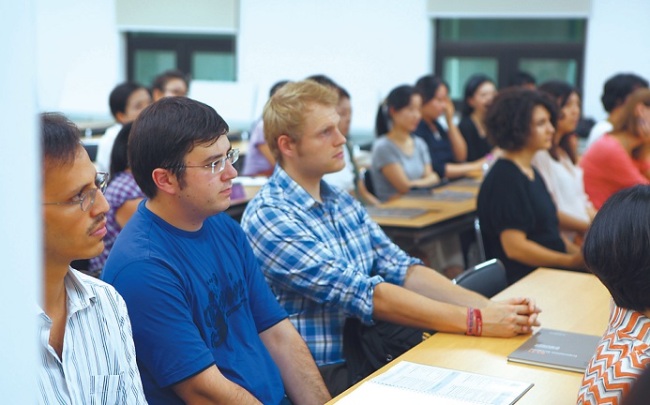[Eye on English]The art of translating Korean texts into English
 |
|
Students attend a class at LTI Korea Translation Academy in Seoul. LTI Korea |
Freelance translator Yi Jin spent some 18 years translating English literature into Korean, but she is now learning to do it the other way around.
“Most English novels that are translated into Korean get that opportunity because they are good,” Yi told The Korea Herald.
“So it’s been very rewarding and fun to introduce them to the Korean reading public. But after many years of doing that, I thought, ‘How come Korean novels don’t get to be translated into English?’ Whenever I read good Korean novels, I found myself thinking, ‘It would be good if this book gets introduced to foreign readers.’”
Yi is one of the small number of translators who are training themselves to translate Korean works of literature into English. While there are many translators who translate English texts into Korean, and their work is in high demand here, the translated texts of Korean novels are mostly aimed at overseas markets.
Yi is attending the Literature Translation Institute of Korea’s Translation Academy, one of the few education institutions that train translators who specialize in literature translation and offer programs for foreigners who wish to translate Korean texts into their mother languages. She said there is something that’s very rewarding about translating works of fiction.
“If 10 people translate a nonfiction text, chances are, the translated texts will be pretty much the same,” she said. “But literary texts are open to different interpretations. My classmates and I all translated one Korean sentence, and everyone’s translation was different. One simply wrote, ‘Silence.’ Another wrote, ‘Everything was quiet.’”
Yi said many of her classmates at the academy have gone to or are currently attending graduate schools specializing in interpretation and translation.
“I think they want to learn specifically about literature translation at the academy,” said Yi.
LTI Korea also invites and supports foreign scholars who major in Korean studies to come to Korea and train to be translators at their academy. They also support the publication of their work.
“We thought foreign translators are much needed in the overseas market (for Korean literature), in terms of promotions, finding overseas publishers and providing translated texts that are easier for foreign readers to read,” said Park So-yeon from LTI Korea. “So we have been running this program for foreign translators and we have had a separate budget for it since about two or three years ago.”
Victoria Caudle, one of the foreign students at the academy, said she appreciates the variety of English-translated Korean literature at the institute. Before arriving in Korea, she studied Korean studies at the School of Oriental and African Studies in the U.K.
“I think what’s so special about the Translation Academy is that it gives scholarships to foreign students to learn Korean, and it ends up producing more natural sounding English versions (of Korean literature),” she said.
Each student at the academy has to translate one piece of Korean short fiction into English. Yi said she particularly appreciates the way her classes are organized, where everyone is asked to participate in debates, rather than just listening to the instructor.
“Everyone in class, including the instructor, would translate a few pages of Korean text into English and we’d talk about it,” she said. “And we’d discuss why some versions of ours work better, while some don’t. I especially like how my instructor is so open to other ideas, and doesn’t present his translation as the ‘right’ version.”
The translators also get to meet Korean authors who write the novels that they are translating into English. Some of the authors who have participated in the program include Kim Young-ha, Eun Hee-kyung, Lee Mun-yol and Kim Hoon.
Caudle said asking Eun specific questions helped her translate her story more accurately.
“There was a scene where a married couple was fighting (in Eun’s story),” Caudle said. “One of them would throw cushions and ashtrays. And we were wondering if they were throwing them in any direction or at each other. And I think she said they were throwing them at each other.”
By Claire Lee (dyc@heraldcorp.com)